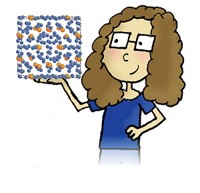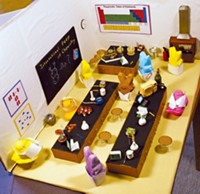Advertisement
Grab your lab coat. Let's get started
Welcome!
Welcome!
Create an account below to get 6 C&EN articles per month, receive newsletters and more - all free.
It seems this is your first time logging in online. Please enter the following information to continue.
As an ACS member you automatically get access to this site. All we need is few more details to create your reading experience.
Not you? Sign in with a different account.
Not you? Sign in with a different account.
ERROR 1
ERROR 1
ERROR 2
ERROR 2
ERROR 2
ERROR 2
ERROR 2
Password and Confirm password must match.
If you have an ACS member number, please enter it here so we can link this account to your membership. (optional)
ERROR 2
ACS values your privacy. By submitting your information, you are gaining access to C&EN and subscribing to our weekly newsletter. We use the information you provide to make your reading experience better, and we will never sell your data to third party members.
Education
Unusual mash-ups of art and science
by Linda Wang
February 26, 2018
| A version of this story appeared in
Volume 96, Issue 9
Science snowflakes

Create a flurry of science-inspired activity in the final weeks of your winter season with the Franklin Institute’s set of 20 science-themed paper snowflake patterns.
The set includes eight patterns celebrating women in science such as Nobel laureate Marie Curie and X-ray crystallographer Rosalind Franklin. The downloadable patterns also include famous scientific inventions, such as the telescope and the Erlenmeyer flask.
“The science of snowflakes is really fascinating,” says Susan Poulton, chief digital officer of the Philadelphia-based science museum, who came up with the idea to use the snowflake cutouts to reach an audience beyond the museum’s visitors. “Museums are very focused on physical attendance, and they don’t often think the same way about their digital audience and how their vision can reach so many more people.”
Poulton tells Newscripts one of her early inspirations for the snowflakes was the paper snowflake patterns of Nobel Prize-winning physicists in the magazine Symmetry in 2014 (C&EN, Jan. 12, 2015, page 40).
Poulton says that since the Franklin Institute launched the outreach effort in mid-December, the snowflakes have been downloaded more than 7,500 times. Graphic designer Anthony Herrera, known for his Star Wars snowflake patterns, created the science-inspired cutups.
The Franklin Institute plans to release a new set of science-themed patterns for every winter holiday season. Next year’s set will include scientists such as Isaac Newton and Rachel Carson.
“It’s seeing folks get interested in science and scientists in totally unique ways,” Poulton says of her passion for this project.
Music appreciation through organic chemistry

What does music have in common with organic chemistry? That’s what assistant professor of chemistry Ginger Shultz wanted her honors organic chemistry students to find out in a special class at the University of Michigan during the fall 2017 semester.
Funded by a grant from the University of Michigan Musical Society, the SOLO project (Singing Octaves and Learning Organic) required the roughly 140 students in Shultz’s class to attend a musical performance and then design a media project that connects music with organic chemistry. Many of the students created music videos about organic chemistry, including a hip-hop-style ode to benzene and a version of songwriter Adele’s “Hello” with the words rewritten to describe addition chemistry.
“The idea is to challenge their notions of what organic chemistry is or what science is and what it means to think about science and push them outside of that box a little bit,” Shultz says. “What was surprising to me was the range of topics they found to connect it to. It was all over the map, which I think shows their creativity.”
Linda Wang wrote this week’s column. Please send comments and suggestions to newscripts@acs.org.





Join the conversation
Contact the reporter
Submit a Letter to the Editor for publication
Engage with us on Twitter